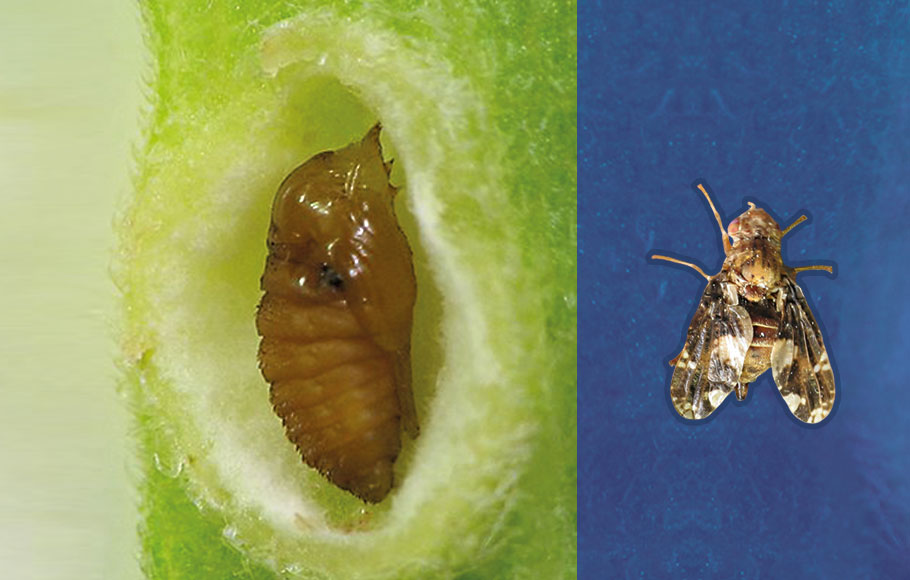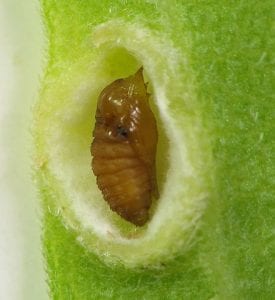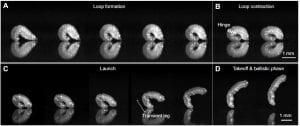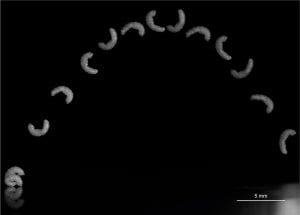
Chhota Bheem maggots puzzles biologist

Like HPV virus prompt growth of warts on our skin, goldenrod gall flies insert eggs near a developing bud. The larvae from the egg stimulate the formation of a bulbous chamber called gall. Michael Wise, a biologist from Roanoke College, Salem, USA, collected a few of the galls to study the worms inside. He dissected about a dozen of galls and extracted the orange coloured worms into a petri dish. He took a break and returned in no time. Looking at the petri dish, he was astonished. There were just two larvae on the plate. Rest of them “were jumping all over the office!” exclaims Wise.
The worm is really tiny, just three millimetres long. How could it jump out of the petri dish? Intrigued Wise was puzzled.
Long jump

About sixteen years ago, on August 30, 2003, Anju Bob made a history of first-ever Indian to win a World Athletics Championships medal at the IAAF World Championships in Paris. Sprinting along the track, she gathered momentum, took off, leapt and landed at 6.70m to finish third and win a bronze medal. Lots of animals can jump. Why then the bewilderment?
This goldenrod gall worm has no legs. It does not have a running start, yet it leapt 25 times its body length in only 2.5 seconds to escape the petri dish. To solve the riddle of the leaping worm, Wise was sure that he has to summon a high-speed video camera.
Friend in need
Sheila Patek is a biologist at Duke University, Durham, USA. Her lab is equipped with an ultra-high-speed video camera that can capture 20,000-frames-per-second. Wise is an old friend of hers, visited her lab and demonstrated the extraordinary take-off of the larvae. Patek was captivated. She readily agreed, thinking it would be fun. A nice distraction from serious research. Once she got into it, she says they “realized this might actually be an interesting new field.” Indeed it turned out to be.
Making the worms pose for a picture is more complicated than clicking a snap of overactive babies. Jumping worms don’t stay put, permitting you to focus. Also, they don’t spring the direction you want them to. As the researches focused the camera onto the tiny-weeny maggot, the field of view of the camera reduced. The grub was just three millimeters, but the leaps ranged from 49 to 121 mm. The tumultuous flight path took the worms away from the field of view hindering the capture of the full flight. Zooming, focusing and keeping the maggot during its entire trip in the field of view was a herculean task.

Moreover, the worms jumped only during August. Additionally, older ones do not leap. Only a few of the gall chambers provided larvae young enough to make the performance. The lab manager Grace Farley had to spend countless hours to get the worms in the frame and obtain decent video films. They had to spend three years before they reached the results. Patience and perseverance, in the end, paid. They got the video, and the fantastic act of jumping of maggots was captured into the video.
The ultra-high-speed video further deepens the mystery. During the hop, the midge larvae could reach even velocity of 0.9 meters/second; that’s whooping 3.24 km per hour. It could accelerate at about 18,000 meters/second². If Anju Bob George 1.85 m the long jump athlete could jump 6.7 meters, that is about 3.6 times, and these perplexing maggot could jump 20-30 times its body length. In human scale, Anju should be able to jump not just 6 meters, but 60 meters. While the insect muscle has about 100 Watts/kilogram muscle power, the force produced during the jumps was in the order of 9,000 Watts/kilogram. What powers the Chhota Bheem maggot?
Incredible mechanism

Farley and his colleagues carefully examined the high-speed video for a clue. The mechanism that powers the Chhota Bheem in the maggot was revealed. The workings are similar to index & thumb finger carrom striking style. We curl our index finger, building downward pressure, and using the thumb to hold back index until we flick the index finger forward. “The secret to the midge’s success is power amplification, the ability to build up force and then release it all at once,” says Farley.
The soft-bodied cylindrical midge larvae, just before the take-off is seen to curl into the shape of the English alphabet “O”. The mouth part was locking into its tail. The internal fluids squeezed into its tail section. The swelling in its hind section causes the hydrostatic pressure build-up. At some point, the building tension overrides the adhesive bond between the head and tail. At this moment, the latch between the head and tail gives away. Whoosh! The hind portion of the worm acts as a leg. Pushing into the substrate, like a released compressed spring, little maggot catapults high into the air for a tumbling flight. The larva spins in loops as it glides back down to the ground.
Electron microscope
The latching mechanism formed by “adhesive micro hairs” between each segment of the worm is novel. Scanning electron microscope image of the larva showed one-micron scale-like projections on the adhesive patches of a leaping gall midge larva. Somehow the scales allow the head and tail to fasten until sufficient tension is build up. What makes them stick? Is it some new kind of interlock mechanism or is it merely van der Waals effect of static electricity that keeps the head and tail locked? Farley says they are not clear. Only future research will illuminate this part of the mechanism.
The direction of the reckless leap is random, and on landing, larva bounces a bit before it is steady again. For the worm, it is more efficient.
Gregg Sutton from the University of Lincoln in the UK calculated that crawling was 28.75 times more costly than jumping.
Original and offbeat jumping of the goldenrod gall larvae could teach a lesson or two says, researchers. Rather than usual conventional crawling, one can think of leaping as locomotion for new-age soft robots. There is a lot more to learn from nature; after all, evolution has experimented a lot more than we can even imagine.

